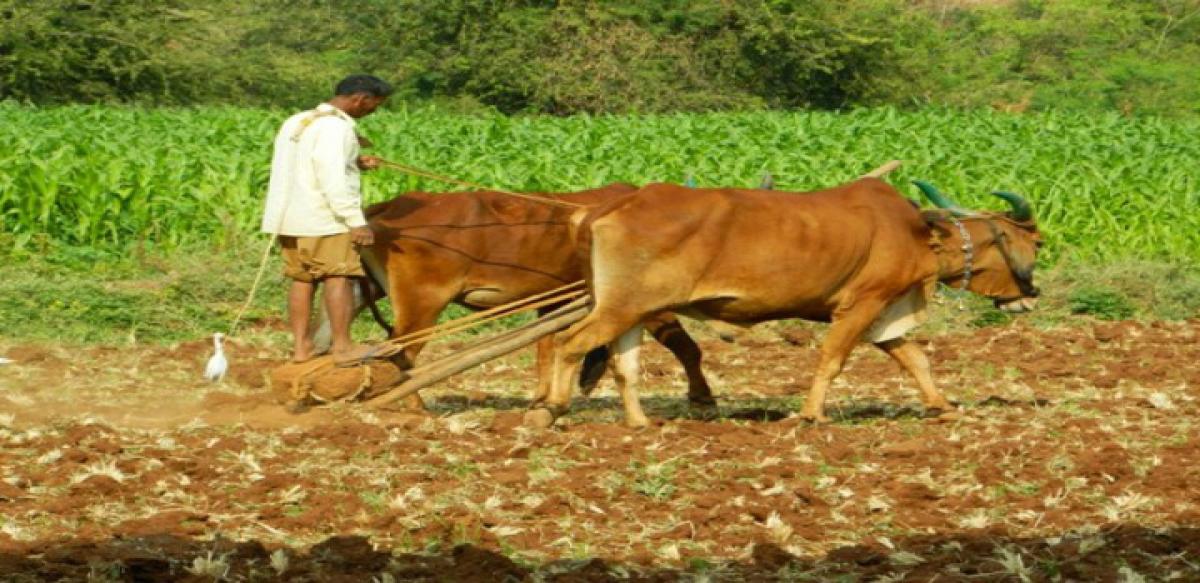Agricultural sector transformation will boost food security

The Economic Survey 2015-16 stressed on the declining growth in agriculture, owing to two consecutive drought years and due to decline in production and area sown of major crops. The agriculture sector needs a transformation to ensure sustainable livelihoods for the farmers and food security for the population.
The Economic Survey 2015-16 stressed on the declining growth in agriculture, owing to two consecutive drought years and due to decline in production and area sown of major crops. The agriculture sector needs a transformation to ensure sustainable livelihoods for the farmers and food security for the population. The transformation in agriculture has to be steered by raising productivity in agriculture, by investing in efficient irrigation technologies, and efficient use of all inputs. Economic Survey 2015-16 emphasises that to improve productivity in agriculture in India needs to be guided by followings:
Irrigation
To raise the productivity of agriculture in India there is need to expand the acreage under irrigation along with adoption of appropriate technologies for efficient utilization of water through suitable pricing. First, adoption of irrigation technologies which improve efficiency in the use of water is imperative in a scenario where flood irrigation has resulted in wastage of water. Second, focus on efficient irrigation technologies is owing to climate change and indiscriminate wastage of water in agriculture and other uses. Having ‘more crop per drop’ through motto to improve productivity in agriculture which can ensure food and water security in the future.
Net irrigated Area to Total cropped area in India
As per the latest available data on irrigation, the all India percentage distribution of net irrigated are to the total cropped area during 2012-13 was 33.9 per cent. There is regional disparity in irrigated farming, with net irrigated area to total cropped area at more than 50 per cent in the states of Punjab, Tamil Nadu and Uttar Pradesh, while it is at less than 50 per cent in the remaining States. There is need to scope for increasing the coverage of irrigated area across the country to increase productivity in agriculture.
There is need to arrest the declining trend in efficient utilization of irrigation potential and also reverse it in the next two three years. A larger share of funds available under the Mahatama Gandhi National Rural Employment Guarantee Act (MGNEREGA)/ other employment generating schemes need to be deployed for creating and maintenance of community assets including de-silting and repair of tanks and other water bodies that are used for irrigation.
Efficiency in Irrigation
Achieving efficiency in the use of irrigation systems will be the main determinant of agriculture productivity. The conventional systems of irrigation have become on-viable in many parts of India due to increasing shortages of water, wastage of water through over irrigation, and concerns of salination of soil as per Task force on Agriculture (NITI Aayog, 2015). The introduction of efficient irrigation technologies which are both economically and technically efficient like drip and sprinkler irrigation can improve water use efficiency , reduce costs of production by reducing labour costs and power consumption.
Water Productivity
Water productivity at the all India level is very low and needs to be enhanced through tapping, harvesting and recycling water, efficient on-farm water management practices, mirco-irrigation (MI), and use of waste water and resource conservation technologies. The overall irrigation efficiency of the major and medium irrigation projects in India is estimated at around 38 per cent. Efficiency of the surface irrigation system can be improved from about 35-40 per cent to around 60 per cent and that of groundwater from about 65-70 per cent to 75 per cent.
Mechanisation
The level of farm mechanisation in India requires more to be done in terms of introduction of better equipment for each farming operation in order to reduce drudgery, to improve efficiency by saving on time and labor, improve productivity, minimize wastage and reduce labor costs for each operation. With shortage of labour for agriculture operations owing to rural urban migration, shift from agriculture to services and rise in demand for labor in non- farm activities, there is need to use labour for agriculture operation judiciously, which makes a strong case for mechanization of farming.
The overall level of mechanization in farming is below 50 per cent in the case of majority of the farming operations in India. With increasing fragmentation of landholdings and low rates of tractor penetration among small farmers, there is need for a market in tractor rentals, akin to cars and road construction equipment, driven by private participation. With suitable mobile and internet applications, manufacturers of tractors along with other stakeholders need to deliberate on this, since it will also increase demand for tractors.
The promotion of appropriate farm equipment which are durable, light weight and low cost, region, crop and operation specific using indigenous/ adapted technologies need to be made available for small and marginal farmers to improve productivity. The basic inputs for increasing productivity in agriculture is seed. It is estimated that the quality for seed accounts for 20-25 per cent of productivity (DAC&FW, 2015).
The issues that require immediate attention are:
(i) Affordability:
Seeds which are open pollinated verities can be developed by farmers from their own harvested crops. However, for high-yielding hybrid verities, the farmer has to depend on the market for each crop.--
(ii) Availability:
Another concern is shortage in the supply of quality seeds. While there is a demand for banning non-certified seeds, certification per-se does not ensure quality seeds Ideally, facilitating more players (private and public) and competition in the market for seeds would improve availability of quality seeds at lower/comprehensive prices.
(iii) Research and technology for seed development.
Inadequate research and genetic engineering has been a constraint in the development of seeds/ seeds technology in major crops during the past few decades in India. There is need to encourage development of seeds/ seed technologies in both private and public sectors to initiate another round of Green revaluation. This development should cover a all agriculture segments/ corps-cereals, coarse cereals, fruits and vegetables, pulses, oilseeds, animal husbandry and pisciculture—simultaneously.
(iv) GM crops and seeds:
Concerns about affordability of hybrids and GM seeds, environmental and ethical issues in cultivation of GM crops, risk to the food chain, dieses spread and cross pollination have resulted in their non-introduction . These issues needs to be debated, tested, evaluated, so that introduction of hybrids is facilitated in the next six months. The adoption of hybrid and HYV seeds is one definite pathway to raising productivity in Indian agriculture.
Fertilizers
Fertilizers are a critical and expensive input required to improve agricultural output. To facilitate and promote the use of fertilizers in order to improve productivity, the Government has been providing fertilizer subsidy to farmers. The fertilizer subsidy is around 10 per cent of the total agriculture GDP in 2013-14.
There is a need to rationalize fertilizer subsidy in an input, crop and region neutral format and minimize diversions. The disbursal of subsidy on fertilizers should shift to DBT, the benefits of which will be maximized, if all controls (including imports) on the fertilizer industry/outputs are lifted simultaneously. In the case of P and K fertilizer subsidy, with the Nutrient Based Subsidy (NBS) scheme, a fixed amount of subsidy will be given on each grade based on their content.
Crop-responsive, balanced use of fertilizers:
It is important to facilitate the optimal use of fertilizers depending on the soil health and fertility status. Linking the soil health card to provide profile of the soil and fertilizer on the basis of the same profile utilizing fertilizer, even if not subsidized can improve the yield of crops.
Micro nutrients and organic fertilizers:
Indian soils show deficiency of micro nutrients like boron, zinc, copper and iron in most parts of the country, which limits crop yields and productivity. According to agronomic trails conducted by the Indian Council of Agricultural Research (ICAR), fertilizers which supplement micro nutrients the range of 0.3 to 0.6 ton per ha. The micro nutrient deficiency can be overcome if there is expansion of the use of organic fertilizer. Moreover, it is cheaper for small farmers to adopt and use organic composting and manure. This can help improve and retain soil fertility. With 67 % of Indian soil characterized by low organic carbon, there is great scope for enhancing the use of organic fertilizers.
Nutrient Management:
Judicious use of chemical fertilizers, bio-fertilizers and locally available organic manures like farmyard manure, compost, vermin compost and green manure based on soil testing is necessary to maintain soil health and productivity.
Regional disparity in fertilizer consumption:
There are wide regional disparities in the consumption of fertilizers. These disparities in fertilizer consumption may be attributed to the availability of irrigation facilities in the high consuming state since irrigation is a requirement for proper absorption of fertilizers. I is necessary to reduce the disparities through appropriate soil-testing faculties and policy measures.
Pesticides:
In India, the farmer’s crop yield losses range from 15 to 25 per cent owing to the presence of weeds, pests, diseases and rodents. However, the use of pesticides without following proper guidelines, use of sub standard pesticides and lack of awareness about pesticides use are key concerns in India. These practices have give rise to pesticide residues being found in food products in India, posing major threats to the environment and human beings.
Farmers need to be educated about the classification of insecticides on rte basis of their toxicity. They should also be advised whether specific pesticides are suitable for aerial application. Being environment friendly, non-toxic and cost effective, bio-pesticides need to be promoted among small farmers to improve productive in agriculture. There is need to address the problem of availability of credit on several fronts.
In respect of high interest rates, DBT may be considered to replace subvention of interest rates. The intermediation and refinance model to promote agricultural credit needs to be revisited and replaced with DBT that shall subsidize the interest paid by the farmer, instead of subsidizing refinance to financial institutions.
The ratio of agricultural credit to agricultural GDP has increased from 10 per cent in 1999-2000 to around 38 per cent by 2012-13. However, the share of long-term credit in agriculture or investment credit has declined from 55 per cent in 2006-07 to 39 per cent in 201-12. The decline in needs to be arrested and reversed.
The regional disparity in the distribution of agriculture credit also needs or be addressed. In India, farmers can avail of crop loans up to Rs. 3lakh at 7k per cent interest and the effective rate of interest has been lowered to 4 per cent during 2015-16 for those who repay their loans promptly. These measures help farmers tide over short-term contingencies and price shocks which may affect their seasonal operations.
The small and marginal farmers with Kisan Credit Cards (KCCs) can also avail the benefit of interest subvention scheme extended for a further period of up to six months (post-harvest) against Negotiable Warehouse Receipts (NWRs) at the same rate as available to crop loan to discourage distress sale of corps by small farmers.
Agriculture Extension Services
Agriculture extension services constitute another key input which can improve productivity in agriculture by providing timely advisory services to farmers to adopt best practices, technology, meet with contingencies, market information etc. In India, though there are multiple agencies offering agricultural advisory services, lack of functional autonomy, rigid hierarchal structures leading to lack of innovative methods of providing extension services and coordination failures at multiple levels have resulted in inefficient deliver of extension services.
There needs to be a shift to demand-driven agricultural advisory services that will cater to farmer, region and crop-specific needs. This can be done through a virtual connect, using IT (mobile and internet), integration of agricultural extension services with all stakeholders, their respective hierarchy, extension services in other villages, blocks, agro climate regions, largely for sharing of information, suppliers of inputs, agro-processors, markets and their activity, especially price.



















